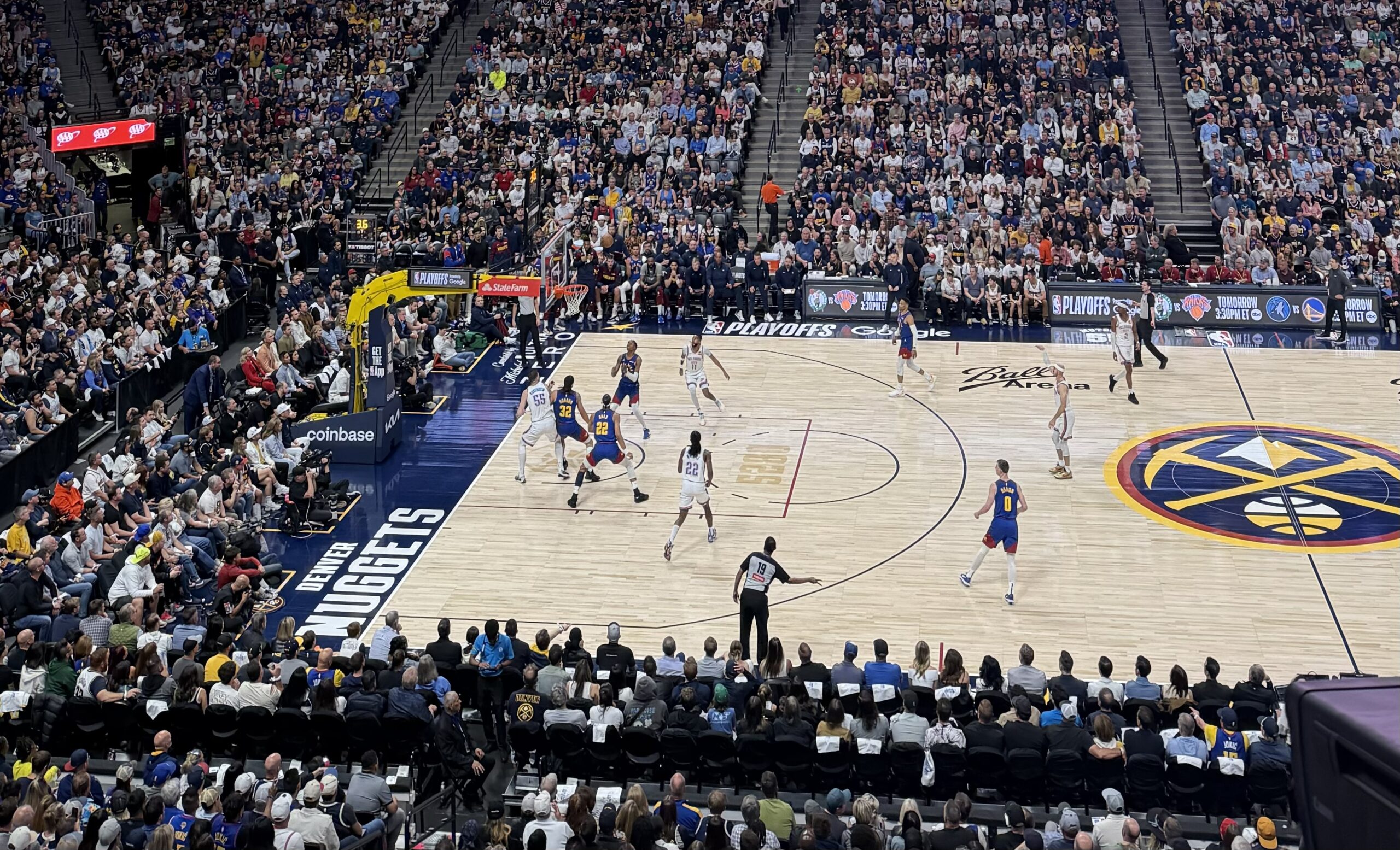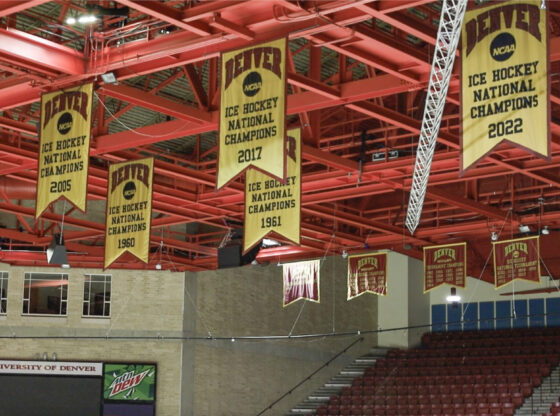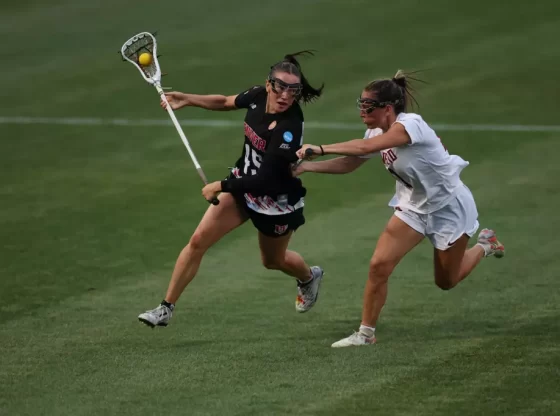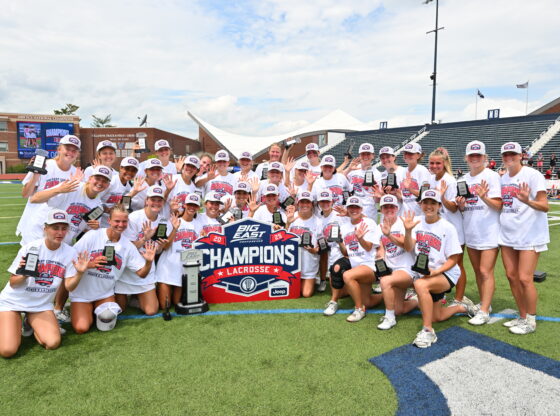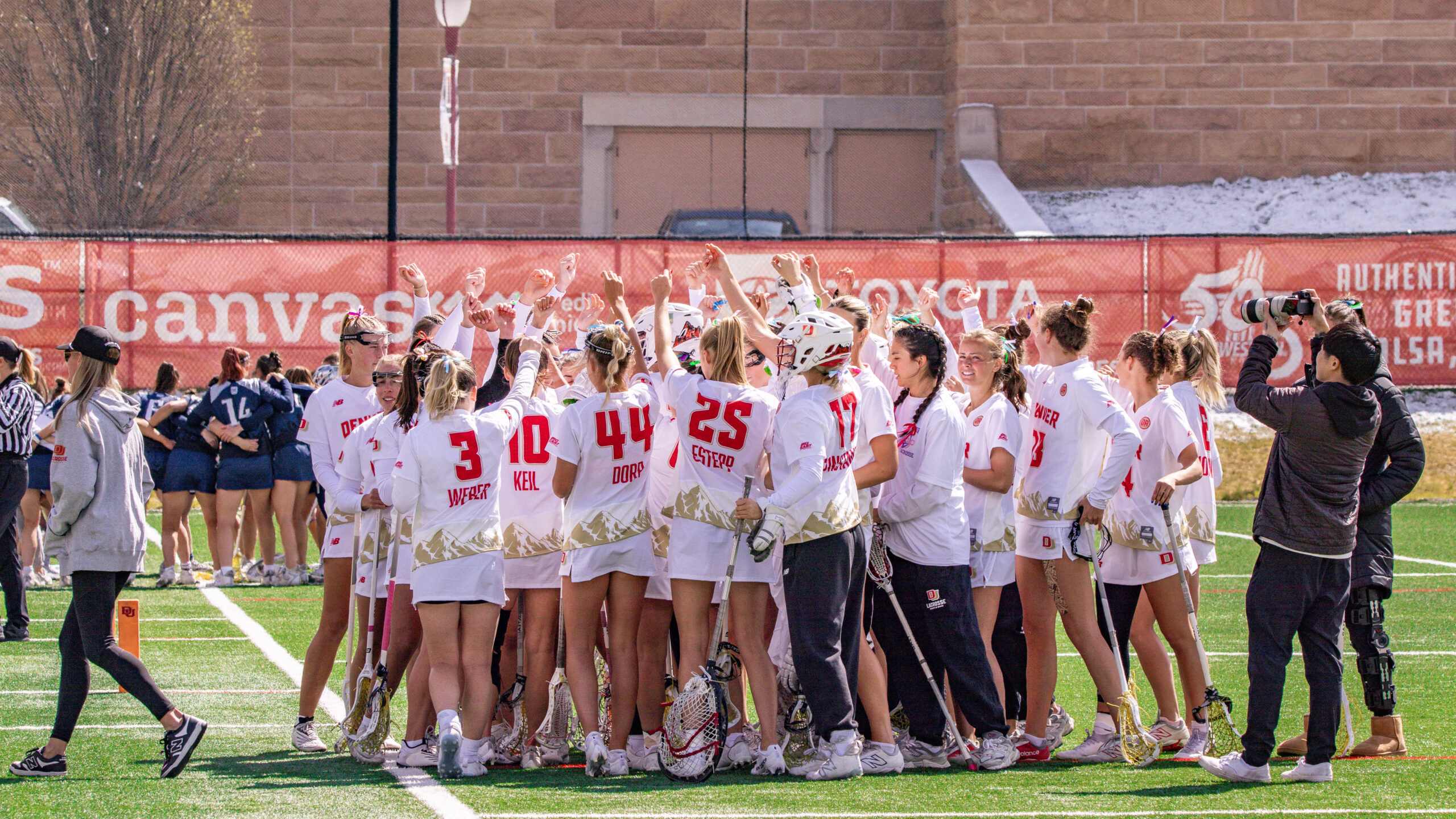In Gothenburg, Sweden, the arena the locals call Scandinavium was buzzing with excitement on the evening of Jan. 5. Thousands of Swedish fans turned up to watch their U20 national ice hockey team compete for first place at the 2024 World Junior Championships (WJCs).
The home crowd was a sea of yellow, matching the striking jerseys that the Swedes had worn in every game of the tournament. Juxtaposing this sea was a streak of blue–the 1960 throwback uniforms of Team USA, who throughout the game would fire 26 shots on net, score six goals and blow countless kisses to the majority Swedish crowd on their way to their sixth gold medal in the tournament’s history.
DU’s own Zeev Buium scored one of USA’s goals, the fourth in a 6-2 routing which helped put the gold medal game out of reach for the Swedes. Behind the bench was Denver’s own David Carle, who at the age of 34 is now one of four American head coaches ever to have won both a NCAA National Championship and a WJC gold medal.
For many DU students, interest in the WJCs might end right there. But one only has to look a little deeper–past the Crimson and Gold representatives, past the gold medal game, past Team USA itself–to find the most celebrated, electric and entertaining international hockey tournament of the year.
Our story begins in two different ends of Gothenburg–two arenas, each home to one of two groups. The first, the aforementioned Scandinavium, hosted group A, consisting of Canada, Finland, Germany, Latvia and Sweden. Just a short drive away stands Frölundaborg, the arena assigned to host group B: Czechia, Norway, Slovakia, Switzerland and the United States.
Each nation faced off against every other team in their group once, making for four preliminary matches for each squad. At the end of these four games, the top four teams in each group would move on to a quarterfinal in a single elimination bracket. The bottom team would have to play one game against the loser of the other group to determine which nation would be relegated to the lower division of the WJCs in 2025.
Norway was the unlucky one in group B, going 0-4 in their preliminary matches. This came as a shock to very few as Norway was the nation that had been just promoted for this edition of the WJCs, their first time in the top division in 10 years. Despite the popularity the sport enjoys with its nordic neighbors, Norway’s hockey program is relatively underdeveloped, with zero NHL draft picks in their 2024 U20 squad and only one Norwegian currently playing in North America’s top league as a full-time roster player (Mats Zuccarello, Minnesota Wild).
These low expectations were briefly put in doubt, however, when they played a respectable 4-1 loss to the USA in their first match–the same USA team which would defeat some opponents by as many as eight. There was fleeting hope that they might be able to defeat Switzerland to avoid the danger of relegation, but Norway lost each of their remaining games by at least four goals.
The ultimate loser of group A, Germany, did not go winless in their preliminary matches. In fact, their first game saw them upsetting Finland, a perennial medal contender, with a head-turning 4-3 victory. This was the first time Germany defeated Finland in the history of the WJCs: 25 losses to now one win.
Electrified, Germany knew all they had to do to guarantee their safety was defeat one of their three remaining opponents. Sweden and Canada would be a tall task, but Latvia would be a more-than-winnable game. Unfortunately, the Latvians jumped out to an early lead which they did not surrender on their way to a 6-2 victory. Germany gave Canada a brief scare, but a 6-3 final in that matchup sent Germany off to play Norway for the right to remain in the top division.
Germany’s small handful of NHL draft picks and more significant hockey pedigree made them the favorites in the relegation battle. Despite this, Norway played their hearts out, keeping level with and even outshooting the Germans. Two Norwegian third period goals forced overtime, with one goal separating each team from safety.
It was Moritz Elias’ quick, elusive skating and snappy wrist shot that sent the Norwegians home heartbroken. After enjoying their first tournament in the top division in a decade, they had once again been relegated. In 2025, Kazakhstan will fill the vacant slot, returning after their most recent relegation in 2020.
Latvia was relieved to have narrowly avoided the relegation zone with their victory over Germany. Latvia is a country that loves hockey: it is one of just three nations on the planet where ice hockey is the most popular sport (the other two being Finland and Canada). However, their international success has been limited by their population, which sits only at about 1.8 million.
It has been this love for hockey which has rescued Latvia at this tournament in the past. They rarely find themselves in contention for medals (although their senior team did win bronze last year in the World Championships), but they are by far the smallest nation which has managed to somewhat consistently stay in the top division at the WJCs.
After predictable losses to Finland, Canada and Sweden, Latvia had the honor of facing the top team in the tournament, USA, in the quarterfinals. Having been at the wrong end of the aforementioned senior World Championship bronze medal game, the US was not about to give the Latvians an inch. A comfortable 7-2 win sent Latvia home, but with something to smile about.
Switzerland secured their spot in the playoff with their 6-2 defeat of Norway. However, they were unable to get within two goals of Slovakia, Czechia or the United States, putting them comfortably in fourth place in group B. Their reward? The right to play against the host country, Sweden, in the first round.
The Swiss found themselves in a hostile arena as massive underdogs, but they didn’t play like it. Despite falling down 2-0 in the first period, they fought back to force overtime. Unfortunately, the referees did not appear to be on their side. A controversial slashing call killed any Swiss momentum leading into the overtime period, and an only-slightly-less controversial hooking call gave Sweden the power play that ended the tournament for Switzerland.
Slovakia’s preliminary round started with a bang: 6-2 over Czechia, who have been their proverbial older brothers in hockey since Czechoslovakia’s split in 1993. Easy victories against Norway and Switzerland set up an ultimate matchup with the USA to determine the winner of group B. Slovakia will soon want to forget the 10-2 loss that followed.
Slovakia was set to play Finland in the quarterfinals thanks to the Finns’ aforementioned loss to Germany dropping their final placement. Thanks to their recent defeat, the Slovaks looked desperate, scoring a late first period buzzer beater and later forcing overtime with 44 seconds remaining in the third period. But alas, more heartbreak. A solo effort by Finnish captain Jere Lassila sent the Slovaks packing, wondering what went wrong.
Canada, having won the previous two tournaments, found themselves in an interesting position. As always, they were a gold medal contender, but several of their best U20 players did not travel to Gothenburg because they were already playing professionally, including 2023 first overall pick and prior year’s WJCs MVP, Connor Bedard.
Regardless, Canadian success is expected at the WJCs. This success was found in the preliminary rounds, but perhaps not to the extent that the thousands of Canadian fans who traveled to Sweden expected. Comfortable wins against Finland and Latvia were shadowed by a shaky performance against Germany and a 2-0 loss to the host nation.
They were set to face an underrated Czechia team in the quarterfinals, a rematch of the 2023 gold medal game. After falling down 2-0 in the first period, the Canadians were able to tie it up with near constant pressure, but their seeming inability to hit the net after that left them vulnerable. The Czechs took advantage, forcing a game-winning own goal with just 11 seconds remaining.
This victory marked another bump in the rollercoaster which had been Czechia’s WJC tournament. After the loss to Slovakia, a victory versus both Norway and Switzerland flanked a narrow shootout loss to the United States. The Czechs had to get revenge against the team that took the gold from them to consider the tournament a success.
After doing so, Czechia faced off against Sweden in the semifinals. Up until this point, Czech goaltender Michael Hrabal was in contention for tournament MVP. However, two unscreened long-range shots inexplicably beat him, forcing his team into a hole which they would not be able to escape. A 5-2 victory for Sweden sent Czechia to the bronze medal game.
Finland, like Czechia, had somewhat of a confusing tournament. After the historical loss to Germany and a well-fought defeat by Canada, they were in serious trouble of having to fight to avoid relegation. Expectedly, they defeated Latvia, setting up a huge game versus Sweden–a game in which they triumphantly defeated their nordic rivals in the shootout.
Spurned on by their strong finish and subsequent quarterfinal victory over Slovakia, Finland faced their toughest opponent yet: Team USA. After taking an early 2-0 lead, Finland found themselves on their heels. The United States all but suffocated them, scoring three unanswered goals and allowing only twelve shots on goal in the final two periods.
With that, the bronze medal game matchup was set. The game started with Finland once again taking a two-goal lead in the first period, inspiring the Czech coach to pull Hrabal, who had until that point not missed a single minute in the tournament. Finland would score three more goals, but a Czech explosion late in the third period–four goals in less than two minutes–devastated the Finns and gave Czechia their second medal in as many years.
After the Czechs took down Finland, there remained only one game. The first combatant? The home team, Sweden, who had enjoyed friendly crowds for the entire tournament. The support of their countrymen helped the Swedes to a dominant first three games of the preliminary round, in which they scored 13 goals, conceded zero and outshot their opponents by an aggregate of 100 to 56.
It wasn’t until the game versus Finland where Sweden finally conceded their first goal of the tournament. Their eventual shootout loss to Finland pointed out some holes in their defense, which up until that point seemed to be ironclad. Their quarterfinal and semifinal matches were less than dominant, but victories in each propelled the Swedes to a home ice gold medal game.
In the other corner stood the deepest and most talented team at the 2024 WJCs: Team USA. The American squad, consisting of 21 NHL draft picks, began their campaign in a businesslike fashion. They took down Norway and Switzerland without much trouble, and while they narrowly escaped Czechia with a shootout win, they flattened Slovakia to finish the preliminary round as the only undefeated team in either group.
Business continued with USA’s routine win over Latvia in the quarterfinals. The deficit they faced early in their semifinal match versus Finland represented the only time they didn’t look like the better team, and the end of the first intermission marked the return of American dominance. This dominance, paired with their high energy and cocky celebrations, made the United States the enemy to the yellow sea of fans at Scandinavium.
The gold medal match started tentatively. Each team seemed to be feeling each other out, avoiding physical play and carefully waiting for opportunities. It wasn’t until American Gabe Perreault’s late period goal when the ice was finally broken.
In the second period, the floodgates opened–Sweden’s Otto Stenberg tied it up just over two minutes after the break, only for Issac Howard to pot two of his own to give USA the lead once again. Swedish star Jonathan Lekkerimäki capitalized on the power play to cut the deficit to two entering the third period. It was anyone’s game.
It was DU’s Zeev Buium who wired a puck into the net for the United States’ fourth goal, silencing the chants of “Sverige! Sverige!” coming from the Swedish majority crowd. After that, it was business once again. Ryan Leonard and Rutger McGroarty each scored and blew a kiss to the fans in celebration.
The Swedes were far from happy. One player threw his broken stick into the protective netting in frustration after the United States’ sixth goal. With 31 seconds left in the game, frustration boiled over and a fight broke out, leaving three Americans and two Swedes sitting in the penalty box. American Goaltender Trey Augustine used the downtime as an opportunity to taunt the crowd.
When the final horn sounded, a smattering of boos rained down and the United States stood alone as U20 champions of the world.
The World Juniors are beautiful and heartbreaking at the same time. Viewers get to enjoy entertaining games played by enthusiastic young men, and the jubilance they show is enough to spur on anyone’s national pride. But it can be hard to watch the other side–the shed tears, the long faces and the dejected body language.
It’s some of the best entertainment a sports fan can find, and it’s all happening again next year.

